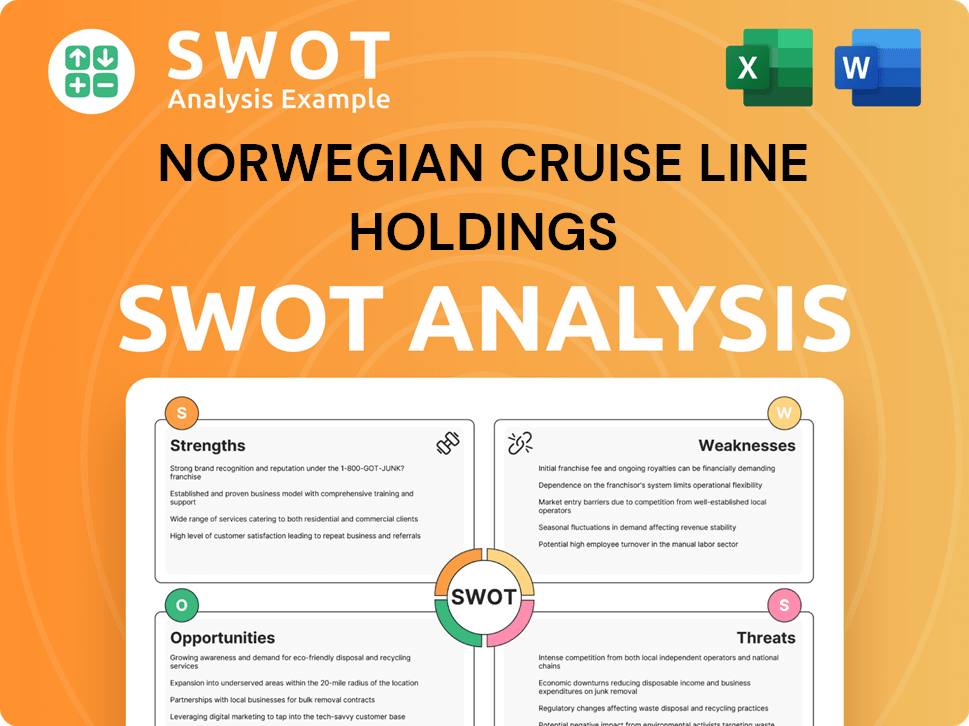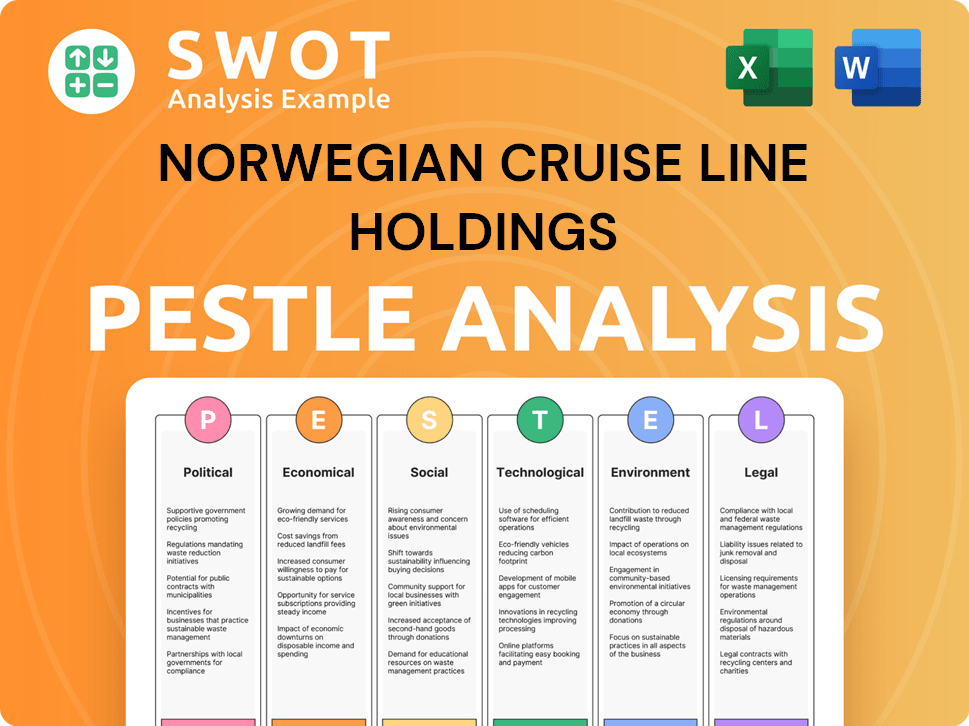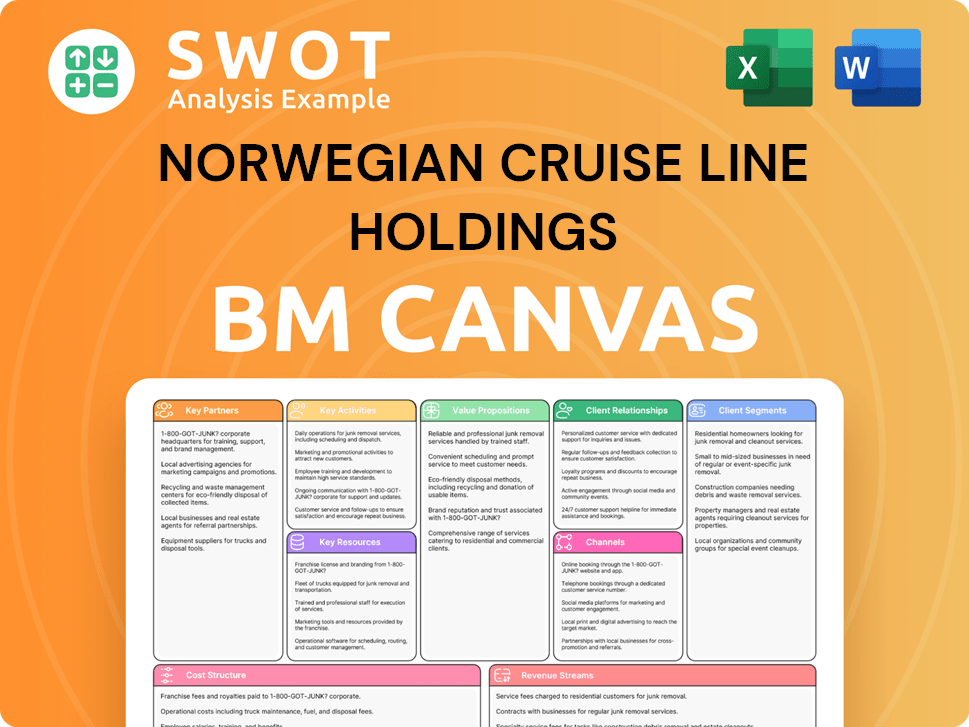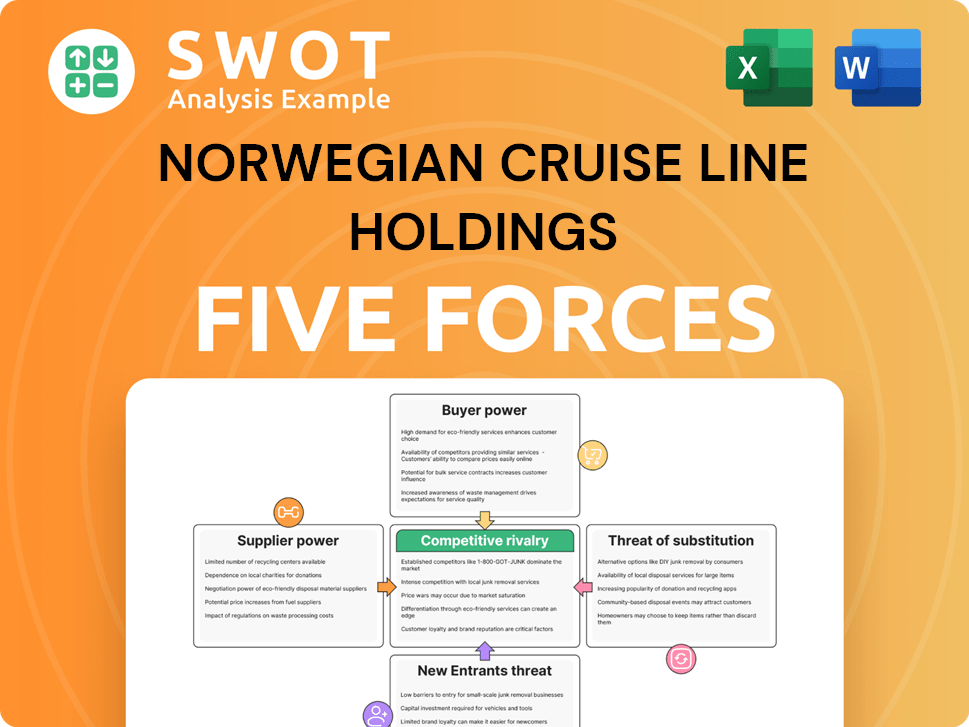Norwegian Cruise Line Holdings Bundle
How Does Norwegian Cruise Line Navigate the Turbulent Waters of the Cruise Industry?
The Norwegian Cruise Line Holdings SWOT Analysis unveils a dynamic industry, shaped by shifting consumer desires and a quest for unique travel adventures. Norwegian Cruise Line (NCLH), a major player, is at the forefront of these changes, consistently adjusting its strategies to fortify its market position. This exploration dives deep into NCLH's competitive environment, providing insights for investors and industry watchers alike.

This in-depth Cruise Industry Analysis will dissect the Competitive Landscape, examining NCLH's rivals and strategic positioning within the Cruise Market. We'll explore NCL Holdings's competitive advantages and how it stacks up against its competitors, providing a clear understanding of the forces shaping the future of cruise line competition. Understanding the market share and strategic initiatives is crucial for anyone looking to understand the future of the sector.
Where Does Norwegian Cruise Line Holdings’ Stand in the Current Market?
Norwegian Cruise Line Holdings Ltd. (NCLH) holds a prominent position within the global Cruise Industry Analysis, recognized as one of the 'Big Three' alongside Carnival Corporation & plc and Royal Caribbean Group. The company's market share consistently places it among the top cruise operators worldwide. As of early 2024, NCLH maintained a significant portion of the global Cruise Market capacity, estimated to be in the double digits, reflecting its extensive fleet and diverse brand portfolio. This substantial presence underscores its competitive strength and ability to attract a broad customer base.
NCLH's core operations are structured around three distinct brands: Norwegian Cruise Line (NCL), Oceania Cruises, and Regent Seven Seas Cruises. NCL targets the contemporary cruise market with its 'Freestyle Cruising' concept, offering flexible dining and entertainment. Oceania Cruises caters to the upper-premium segment, focusing on culinary experiences and destination-rich itineraries, while Regent Seven Seas Cruises serves the ultra-luxury market with all-inclusive voyages. This multi-brand strategy enables NCLH to serve a wide range of customer segments, from families and active travelers to discerning luxury seekers, enhancing its overall market reach and resilience.
NCLH's strategic focus on premium and luxury segments, through Oceania and Regent Seven Seas Cruises, allows the company to capture higher-yielding customers, improving profitability. The company's financial health, as demonstrated in its Q1 2024 earnings, showed a significant year-over-year improvement in net income and strong revenue growth, indicating a robust recovery and positive financial outlook. For example, in Q1 2024, NCLH reported revenues of approximately $2.18 billion, a substantial increase compared to the previous year, reflecting a strong rebound in demand and operational efficiency. The company continues to explore expansion opportunities in regions like Asia, where the cruise market is still developing but shows considerable potential for growth. For more details on the company's financial model, consider reading about the Revenue Streams & Business Model of Norwegian Cruise Line Holdings.
NCLH maintains a strong market position within the global cruise industry, ranking among the top operators. Its market share is consistently in the double digits, reflecting its significant capacity and brand portfolio. This strong position allows NCLH to compete effectively and capitalize on market opportunities.
NCL's competitive advantages include its multi-brand strategy, which caters to diverse customer segments. Its 'Freestyle Cruising' concept provides flexibility, and its focus on premium and luxury segments boosts profitability. The company's strong financial performance, with significant revenue growth, further strengthens its position.
NCL's main rivals include Carnival Corporation & plc and Royal Caribbean Group, forming the 'Big Three' in the cruise industry. These companies compete across various market segments, from contemporary to luxury cruises. The competitive landscape involves factors like pricing, itineraries, and onboard experiences.
Market trends include increasing demand for premium and luxury cruises, as well as expanding itineraries in emerging markets. Challenges include fluctuating fuel costs, geopolitical instability, and the need to adapt to evolving consumer preferences. Sustainability and environmental concerns are also significant factors.
NCL's financial performance in Q1 2024 showed significant improvements, with revenues reaching approximately $2.18 billion. This strong revenue growth reflects a robust recovery in demand and operational efficiency. The company's strategic initiatives, such as focusing on premium and luxury segments, have contributed to improved profitability.
- Strong revenue growth in Q1 2024.
- Focus on higher-yielding customer segments.
- Expansion into emerging markets like Asia.
- Effective cost management and operational efficiency.
Norwegian Cruise Line Holdings SWOT Analysis
- Complete SWOT Breakdown
- Fully Customizable
- Editable in Excel & Word
- Professional Formatting
- Investor-Ready Format

Who Are the Main Competitors Challenging Norwegian Cruise Line Holdings?
The competitive landscape for Norwegian Cruise Line Holdings Ltd. (NCLH) is primarily shaped by the intense rivalry within the global cruise market. The cruise industry is characterized by high capital expenditures, significant operational costs, and fluctuating demand influenced by economic conditions and global events. Understanding NCLH's competitive position requires a deep dive into its key rivals and the strategies they employ.
The cruise industry's competitive dynamics involve constant innovation in ship design, onboard amenities, and entertainment to attract customers. Additionally, effective marketing and distribution networks are crucial for reaching target markets and building brand loyalty. The company's financial performance and market share are directly influenced by these competitive factors.
NCLH faces significant competition from major players in the cruise industry. These competitors challenge NCLH across several fronts, including pricing, innovation, and marketing.
Carnival Corporation is the largest cruise company globally, operating a diverse portfolio of brands. These brands include Carnival Cruise Line, Princess Cruises, and Holland America Line. Carnival's broad range of offerings directly competes with NCLH's varied cruise experiences.
Royal Caribbean Group is another major competitor, known for its innovative ships and extensive onboard activities. Royal Caribbean International, Celebrity Cruises, and Silversea are part of this group. They compete with NCLH in both contemporary and luxury segments.
Price competition is a constant factor, particularly in the contemporary segment. All major lines compete for market share by adjusting prices and offering promotions. This impacts the profitability of all cruise operators.
Innovation in ship design and onboard amenities is a critical battleground. Companies invest heavily to differentiate their offerings and build customer loyalty. Royal Caribbean's introduction of larger ships has directly challenged NCL's 'Freestyle Cruising' concept.
Branding and marketing efforts are intense, with significant investments to build brand recognition. Distribution networks, including travel agent partnerships and direct-to-consumer channels, are crucial. These channels help reach target markets effectively.
Beyond the 'Big Three' – Carnival, Royal Caribbean, and NCLH – the Marketing Strategy of Norwegian Cruise Line Holdings also faces competition from smaller, specialized cruise lines. These lines focus on niche markets, such as expedition cruises or river cruises. Emerging players, particularly those focusing on sustainable or experiential travel, could also disrupt the traditional competitive landscape. Mergers and alliances could also reshape the competitive dynamics. For example, any significant consolidation among smaller players could create a more formidable challenger in specific market segments.
Several factors influence the competitive landscape for NCLH, including market share, pricing strategies, and operational efficiency. Understanding these factors is crucial for assessing NCLH's position in the cruise market.
- Market Share: The "Big Three" – Carnival, Royal Caribbean, and NCLH – collectively hold a significant portion of the global cruise market share. In 2024, these companies continue to vie for market share through various strategies.
- Pricing Strategies: Cruise lines use dynamic pricing models, adjusting prices based on demand, seasonality, and competition. Price wars can impact profitability.
- Operational Efficiency: Efficient operations, including fuel management and supply chain optimization, are critical for controlling costs. These efficiencies directly affect the company's competitiveness.
- Innovation: Investing in new ship designs, onboard experiences, and entertainment options is crucial for attracting customers. Innovation helps differentiate offerings and enhance brand appeal.
- Marketing and Branding: Effective marketing campaigns and strong brand recognition are essential for building customer loyalty and driving demand. These efforts help in attracting and retaining customers.
- Distribution Channels: Strong relationships with travel agents and effective direct-to-consumer channels are crucial for reaching target markets. These channels ensure that cruises are accessible to potential customers.
Norwegian Cruise Line Holdings PESTLE Analysis
- Covers All 6 PESTLE Categories
- No Research Needed – Save Hours of Work
- Built by Experts, Trusted by Consultants
- Instant Download, Ready to Use
- 100% Editable, Fully Customizable

What Gives Norwegian Cruise Line Holdings a Competitive Edge Over Its Rivals?
Norwegian Cruise Line Holdings Ltd. (NCLH) carves out a strong position in the Cruise Market through a multi-brand approach and innovative offerings. Its strategic moves, including the introduction of the 'Freestyle Cruising' concept, have significantly shaped the Competitive Landscape. NCLH's focus on diverse customer segments, from contemporary to ultra-luxury, allows it to maximize market penetration and adapt to evolving consumer preferences.
The company's key milestones involve fleet modernization and the introduction of new ships with advanced features. These investments are crucial for maintaining a competitive edge in the Cruise Industry Analysis. NCLH's strong brand equity and customer loyalty, especially within its distinct brands like Regent Seven Seas Cruises, are significant advantages, fostering repeat bookings and positive word-of-mouth referrals.
NCLH's success is driven by its operational efficiencies and strategic itinerary planning, which contribute to its competitive standing. The company's extensive distribution networks, including strong relationships with travel agencies and robust online booking platforms, ensure a wide market reach. These factors collectively enhance NCLH's ability to compete effectively, providing a solid foundation for future growth and market leadership.
NCLH's multi-brand strategy, encompassing Norwegian Cruise Line, Oceania Cruises, and Regent Seven Seas Cruises, targets diverse customer segments. This allows the company to cater to a wide range of preferences and budgets, enhancing its market reach. This approach is crucial for maintaining a competitive edge and adapting to changing market dynamics.
The 'Freestyle Cruising' concept, pioneered by NCL, offers flexible dining and entertainment options without fixed schedules. This innovative approach fosters customer loyalty and attracts travelers seeking a less structured cruise experience. This unique offering differentiates NCL from competitors and enhances its appeal to a broader audience.
Each of NCLH's brands has cultivated a strong reputation within its respective segment, leading to repeat bookings and positive word-of-mouth referrals. Regent Seven Seas Cruises, for instance, is known for its all-inclusive luxury and personalized service, attracting a discerning clientele. This strong brand equity is a key driver of customer loyalty and market share.
Economies of scale provide NCLH with advantages in procurement, fuel efficiency, and operational costs, enhancing its competitive standing. The company's optimized itinerary planning and extensive distribution networks further contribute to its market reach. These efficiencies are critical for maintaining profitability and competitiveness in the Cruise Industry Analysis.
NCLH's competitive advantages include its multi-brand strategy, 'Freestyle Cruising' concept, strong brand equity, and operational efficiencies. These elements work together to provide a robust market position. The company's strategic initiatives and investments in fleet modernization further strengthen its competitive standing.
- Multi-brand strategy targeting diverse customer segments.
- 'Freestyle Cruising' concept fostering customer loyalty.
- Strong brand equity and repeat bookings.
- Operational efficiencies and optimized itinerary planning.
Norwegian Cruise Line Holdings Business Model Canvas
- Complete 9-Block Business Model Canvas
- Effortlessly Communicate Your Business Strategy
- Investor-Ready BMC Format
- 100% Editable and Customizable
- Clear and Structured Layout

What Industry Trends Are Reshaping Norwegian Cruise Line Holdings’s Competitive Landscape?
The competitive landscape for Norwegian Cruise Line (NCL) is shaped by evolving industry trends, presenting both challenges and opportunities. Understanding these dynamics is crucial for assessing NCL's market position and future prospects. The cruise industry, including NCL Holdings (NCLH), faces constant pressure to adapt to changing consumer preferences, technological advancements, and global economic conditions.
Analyzing the competitive environment for cruise lines requires a deep dive into market trends, strategic initiatives, and the financial performance of key players. This involves examining factors influencing cruise line competition, including pricing strategies, target market analysis, and the impact of external events such as health crises and geopolitical instability. For anyone interested in the cruise industry, a Brief History of Norwegian Cruise Line Holdings offers valuable context.
Key trends include the demand for enhanced digital experiences, stricter environmental regulations, and a shift towards experiential travel. Consumer preferences are moving towards sustainable practices and unique itineraries, with a growing interest in smaller ships. The global economic climate, including inflation, also impacts the cruise market.
Challenges include the need for significant capital expenditure to meet environmental regulations and continuous innovation to satisfy consumer demands. Intensified price competition and the emergence of new niche cruise experiences pose threats. Geopolitical instability and health crises continue to present risks to cruise operations.
Opportunities exist in developing unique itineraries, investing in sustainable technologies, and exploring growth in emerging markets. Strategic partnerships and adapting to evolving trends can strengthen NCLH's competitive position. This includes capitalizing on the growing demand for experiential travel and sustainable practices.
The cruise market is expected to continue its recovery in 2024 and 2025, with a focus on increased onboard spending and higher occupancy rates. The industry is projected to generate substantial revenue, with continued investments in new ships and technologies. The competitive landscape will likely intensify as major players vie for market share.
NCL's strategic initiatives include fleet modernization, enhanced onboard experiences, and expansion into new markets. Competitive advantages include brand recognition, diverse itineraries, and a strong focus on customer satisfaction. Analyzing Norwegian Cruise Line's financial performance and strategic initiatives reveals its ability to adapt to market changes.
- Fleet modernization to meet environmental standards and enhance customer experience.
- Expansion into new destinations and markets to diversify revenue streams.
- Investment in technology to improve booking systems and onboard services.
- Strategic partnerships to enhance offerings and expand market reach.
Norwegian Cruise Line Holdings Porter's Five Forces Analysis
- Covers All 5 Competitive Forces in Detail
- Structured for Consultants, Students, and Founders
- 100% Editable in Microsoft Word & Excel
- Instant Digital Download – Use Immediately
- Compatible with Mac & PC – Fully Unlocked

Related Blogs
- What are Mission Vision & Core Values of Norwegian Cruise Line Holdings Company?
- What is Growth Strategy and Future Prospects of Norwegian Cruise Line Holdings Company?
- How Does Norwegian Cruise Line Holdings Company Work?
- What is Sales and Marketing Strategy of Norwegian Cruise Line Holdings Company?
- What is Brief History of Norwegian Cruise Line Holdings Company?
- Who Owns Norwegian Cruise Line Holdings Company?
- What is Customer Demographics and Target Market of Norwegian Cruise Line Holdings Company?
Disclaimer
All information, articles, and product details provided on this website are for general informational and educational purposes only. We do not claim any ownership over, nor do we intend to infringe upon, any trademarks, copyrights, logos, brand names, or other intellectual property mentioned or depicted on this site. Such intellectual property remains the property of its respective owners, and any references here are made solely for identification or informational purposes, without implying any affiliation, endorsement, or partnership.
We make no representations or warranties, express or implied, regarding the accuracy, completeness, or suitability of any content or products presented. Nothing on this website should be construed as legal, tax, investment, financial, medical, or other professional advice. In addition, no part of this site—including articles or product references—constitutes a solicitation, recommendation, endorsement, advertisement, or offer to buy or sell any securities, franchises, or other financial instruments, particularly in jurisdictions where such activity would be unlawful.
All content is of a general nature and may not address the specific circumstances of any individual or entity. It is not a substitute for professional advice or services. Any actions you take based on the information provided here are strictly at your own risk. You accept full responsibility for any decisions or outcomes arising from your use of this website and agree to release us from any liability in connection with your use of, or reliance upon, the content or products found herein.